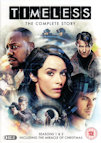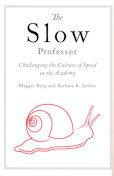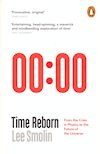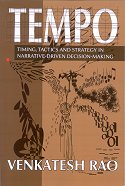His'n'hers Christmas presents (oh, there was also a soldering iron and mat, but they're not books...)
Wednesday, 25 December 2024
Friday, 27 September 2024
Saturday, 7 October 2023
review: The Order of Time
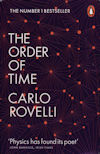 Carlo Rovelli.
Carlo Rovelli.The Order of Time.
Penguin. 2017
In his previous book, Reality Is Not What It Seems, Rovelli emphasises the need to remove the Newtonian model of a separately existing time from physical theories. In this new similarly slim and equally lucid volume, he delves deeper into what is this time thing, anyway.
He carefully picks apart the many different models of time in physics. Newtonian time has been replaced by many different models of time, all of which remove one or more ‘obvious’ properties. Special relativistic time depends on your speed, and asking what is now somewhere else “is like asking ‘What is here, in Peking?’”[p.37]: the present is defined just in a local bubble whose size depends on our precision. General relativistic time depends on the curvature of space, and so is different everywhere, and things fall because “the movement of things inclines to where time passes more slowly” [p.12]. Thermodynamics is the only basic physical theory that has an ‘arrow’ of time, of entropy increase, the existence of which depends on your scale; that “entropy exists because we describe the world in a blurred fashion”, and if we “observe the microscopic state of things the difference between past and future vanishes” [p.30]. Quantum mechanical (space)time is not continuous, but granular, as is everything else, and different times can coexist in superpositions.
Rovelli provides an interesting historical perspective on our current everyday intuitions of it being the same time in different places, and time always passing at the same speed: we didn’t always have these ideas. Clocks didn’t start started regulating our hours until around the 14th century. But these clocks were synchronised to local noon, not to each other. Then train timetables in the 19th century required synchronisation across distances. Time zones were invented in 1883, and cities gradually synchronised their clocks with each other. Then, in 1905, Einstein destroyed the idea of universal synchronicity. (I had known Einstein worked in a patent office; I was not aware he dealt specifically with patents related to synchonising clocks!) So, ironically:
[p56] only a few years passed between the moment at which we agreed to synchronize clocks and the moment at which Einstein realized that it was impossible to do so exactly.
Another interesting historical perspective: today we are accustomed to the idea the Newton’s view of an independently flowing absolute time, and think that Leibniz was some maverick suggesting relational time, of time being change. But actually, this view of time being dependent on change was the orthodox Aristotelian view, and it was Newton who was the maverick. We are just nowadays more used to the Newtonian view. Einstein synthesised the Aristotelian and Newtonian views: yes, spacetime is something real, yet it is relative, not absolute. And its reality is like other kinds of things that are real:
[p67] Spacetime is the gravitational field – and vice versa. It is something that exists by itself, as Newton intuited, even without matter. But it is not an entity that is different from the other things in the world – as Newton believed – is a field like the others. More than a drawing on a canvas, the world is like a superimposition of canvases, of strata, where the gravitational field is only one among others. Just like the others, it is neither absolute nor uniform, not is it fixed: it flexes, stretches and jostles with the others, pushing and pulling against them. Equations describe the reciprocal influences that all the fields have on each other, and spacetime is one of these fields.
Having spent the first part of the book bringing us up to date with current physics, Rovelli moves into more a speculative realm, a different view of time in terms of change. This is heady stuff. We should think of the world as a network of events, and “the simple fact that nothing is: that things happen instead” [p.85]. In this world there is no time as we currently understand it; instead it is
[p86] a world in which change is ubiquitous, without being ordered by Father Time; without innumerable events being necessarily distributed in good order, or along the single Newtonian timeline, or according to Einstein’s elegant geometry.
This gives a different perspective of what the world is made of:
[p86-7] We can think of the world as made up of things. Of substances. Of entities. Of something that is. Or we can think of it as made up of events. Of happenings. Of processes. Of something that occurs. Something that does not last, and that undergoes continual transformation, that is not permanent in time. The destruction of the notion of time in fundamental physics is the crumbling of the first of these two perspectives, not of the second. It is the realization of the ubiquity of impermanence, not of stasis in a motionless time.
In terms of events and processes, things are just (possible very) long-lived events: “‘Things’ in themselves are only events that for a while are monotonous.” [p.92]
Rovelli explains how some of the problems we have with this new physics is down to grammar: the human languages we use to talk about the world, with their simple past, present and future tenses, do not fit well with our current view of a more complex structure to physical time. But just because natural language, developed before we knew about this complexity, can’t cope, doesn’t mean our physical models are wrong: we just have to work harder.
Rovelli concludes his discussion with some thoughts on the origins of time: how it might emerge from the underlying granular, complex structure of spacetime events; from a particular blurring (ignorance) of macroscopic state; from non-commutative quantum operations imposing a natural (partial) order; from the fact that we have a point of view observing the universe while situated within it.
This is a beautifully written book, explaining complex concepts with great clarity and style. It is a translation. There is an amusing translation error on p193, which talks of “a degree of liberty”: after a moment of thought, I decided that this should be “a degree of freedom”. Despite the book’s slimness, there is a great deal to think about here; I have merely scraped the surface in my summary above. It is a wonderfully rich concoction of deep ideas and lucid explanation. Recommended.
For all my book reviews, see my main website.
Friday, 2 July 2021
TV review: Timeless season 1
One the one hand, this is great, with an exploration of multiple historical vignettes as the team bounce through time trying to stop Flynn, and as the reason for Flynn’s actions is gradually revealed. Also, the racism and sexism in the past are highlighted: Rufus notes that there is nowhere in history where it was a good time to be a black man; Lucy doesn’t fare that well sexism-wise either, but does manage to get away with several snappy comebacks. (There is an implicit assumption that racism and sexism are no longer a problem in the present, but where else did Lucy get those comebacks?)
On the other hand, it is totally bonkers, with the results of changes in the past having essentially only single effects on the future. For example, the first episode has the conflicting efforts of Flynn and the team meaning that the Hindenburg passengers didn’t die. The only visible effect once they get home is that Lucy’s beloved sister Amy disappears from the timeline and her mother is no longer dying of lung cancer; Amy’s father (who turns out not to be Lucy’s father, to her great surprise, and of subsequent plot importance) married a descendent of a Hindenburg survivor in the changed timeline. So Lucy’s mother never married, and never started smoking. But she still lives in the same house, with the same furnishings, as before… In fact, there’s a bit of a running joke of finding out what change to history resulted from their actions each time, like an extra James Bond film, or a different person being the recognised hero of the event. Also, Lucy, apparently involved because of her encyclopaedic knowledge of history, should become steadily more useless as the past moves away from her knowledge of it.
So, don’t think too carefully about the logic of the timelines. Instead, sit back and enjoy the interesting views of historical events.
For all my SF TV reviews, see my main website.
Friday, 23 March 2018
bus stop time
time is a device to prevent everything happening at once,And now I have discovered that Cambridge Railway Station bus stops each have their own time zone!
space is a device to prevent it all happening in Cambridge
 |
| I wonder what the time is at the other railway station stops? |
Sunday, 14 May 2017
book review: The Slow Professor
The Slow Professor: challenging the culture of speed in the academy.
University of Toronto Press. 2016
There is an external view of academics as ivory tower effete dilettantes who spend all their time swanning around, thinking big thoughts, or just kicking back during the long vacations. There’s no real work involved, is there?
Then there is the reality: ever increasing bureaucracy, more scrabbling for more students, more worrying about “student feedback”, more scrabbling for ever reducing (per capita) research funding, more pressure to publish. I spent nearly two decades in industry, and have spent over a decade in academia: I can say with conviction that academia is much harder work and longer hours.
Bosses will say, but that’s because academia is vocational: you work so hard because you enjoy it. Well, we enjoy some of it, maybe even most of it, which is more than many people can say. But also if we don’t work so hard, we fall behind harder working peers, we don’t get promoted, we don’t get the research funding, we get in a death spiral. It’s a classic tragedy of the commons. And when we claim we are stressed because we have too much work to do, we are sent on time management courses (which we have no time for), rather than having workload reduced.
This thought-provoking little book (a mere 90 pages of text, to be digestible by the hurried academic, yet sufficiently dense with references to be academically rigorous), analyses the problem, and advocates slowing down, and savouring, the academic life. This is by explicit analogy with Slow Food and as a part of the Slow Movement in general. There are chapters on teaching, and research, and, crucial for academic learning, on collegiality. The call is for individual researchers to regain a sense of agency in the face of overpowering bureaucracy.
The authors write from the perspective of social scientists, but the findings and comments are equally applicable to other disciplines. The book documents much evidence of the problems, and suggests some approaches to mitigate these:
[p59] What does “time for the self” mean in the context of scholarship? For me, it means a shift from the dominant view of time as linear and quantifiable to time as a process of becoming. That is, rather than thinking of time as an accumulation of “lines on the CV” …, I am trying to think of time as an unfolding of who I am as a thinking being. Broadly speaking, I am trying to shift the focus from the product (the book, the article, the presentation) to the process of developing my understanding. This is not to say that books and articles and presentations don’t get written (although there may be fewer of them), but my experience of writing them changes in the sense that shifting my focus in this way eases some of the time pressure. I can keep at the back of my mind Readings’s question, which applies to our students as much as it does to us: “How long does it take to become educated?” … We tend to think of time as spent and gone. However, thinking of time as “constitutive, a becoming of what has not been before” … connects us to the scholarship that we do and goes against the corporate model.How well this will go down with that “overpowering bureaucracy” remains to be seen. The issue with bureaucrats is they focus on those outputs, on those products, (presumably) because those are easy to measure, to count, to quantify. Students are to be assessed against learning outcomes: have they learned X, Y, Z? Yet students should grow and learn and change, through a process of becoming educated to think, and gaining meta-skills that can be adapted in a changing world. Research is to be assessed by publication and impact: how many journal papers and books? Yet researchers should grow and learn and change, through a process of reflection, and thinking, and experimenting. With much of academia, both teaching and research, most of the value lies in this process of becoming, hard to measure, even invisible in some cases. How much work are you really doing when reading a book, or staring at a screen, or just staring into space, thinking? Where’s the output, the result, the evidence of your work?
Learning and discovering and critiquing and thinking, like the rest of life, is a verb, not a noun.
I must read more about this Slow Movement. If I can find the time.
For all my book reviews, see my main website.
Friday, 14 April 2017
Innominate Eastercon - Friday
The first session I attended was a two-person panel on Biotechnology and the Law. Dr Helen Pennington and Dr Colin Gavaghan talked on a variety of aspects of how the law is maybe failing to keep up with scientific advances. CRISPR/Cas9, a technique to edit out genes from the genome, was mentioned a lot, including the fact that it can be used to produce GM organisms that are indistinguishable at the DNA level from organisms “naturally” bred to have the gene removed. The consensus was that items should be labelled so consumers could exercise choice: some don’t want to eat GM food, some prefer GM food, as it doesn’t tend to have the trace amounts of natural fungal microtoxins that organic food does. Nevertheless, Scotland and New Zealand have banned the growing of all GM crops, not just food crops, in order to present a clean “green” image; this is ironic, given that Scotland does not exactly have a healthy food reputation! The current “over the counter” availability, cheapness and ease-of-use of CRISPR led on to discussion of potential dangers; the panellists weren’t too worried, given the difficulty of keeping the GM organism alive: “any back-garden bio-terrorist is likely just to kill themselves, and a couple of neighbours”. Given the potential untraceability of GM organisms, the suggestion was the most important legislation change is to require registering trials and publishing results, as is now beginning to happen for medical trials, to stop the covering up of “mistakes”.
 |
| Victorian times: Dinner in the Iguanodon Model, 1854 |
Next I went to a talk on Dinosaurs in fact and fiction by Dr Will Tattersdill. Dinosaurs are complicated: there are the “real” dinosaurs that existed in Deep Time, and there is our changing knowledge of dinosaurs since their discovery in Victorian times, to our better but still imperfect knowledge today. They form a perfect link between the “two cultures” of arts and sciences: you can’t have a dinosaur without scientific activity and physical evidence, but you need imagination and art to “flesh out” a whole animal from a few bones or partial skeleton. As science advances, our knowledge increases, but our dead images, our wrong images, stay with us, too, in books, in toys. Arguing that these “old” dinosaurs are wrong is robbing us of our pasts, of our childhoods, in much the same way that arguing Pluto is not a planet does. We have a nostalgia for outmoded science. In his essay “Dinomania” Stephen Jay Gould writes “When I was a child, ornithopods laid their eggs and then walked away forever. Today these same creatures are the very models of maternal, caring, politically correct dinosaurs.” Just look at the tenses and model of time in that quote! Will speculates that dinosaurs are perfect for SF readers: we have the “cognitive agility” to hold multiple worlds, each with their own rules, and complex models of time, in our heads; this skill is needed to hold all the different “human pasts” of dinosaurs, too. The talk covered more: history, cultural imperialism, phylogenetic trees, gender, SF stories, … you name it. Brilliant stuff; I’m looking forward to his book due out end of 2019.
Next came David Allan’s quiz, loosely based on Pointless. The team of 4 did well, hampered as they were on occasion by one of the options not appearing on their sheets, only on the screen visible to the audience. Picture round: Name the alien. Alternate letter round: Fictional planets: _A_I_O_R (Majipoor), _A_L_F_E_ (Gallifrey), A_R_K_S (Arrakis), M_D_E_I_ (Midkemia), Title of First Novel in Trilogy on Being Given the Second, … When the surprisingly low scores for some of the more obvious options were revealed, the audience demanded to know who on earth the consulted panel were.
Then it was time for the opening ceremony. As traditional, the Guests of Honour were invited up onto the stage, as were the con committee, for applause. Afterwards, Dr Emma King from the Royal Institution gave an excellent presentation that involved lots of things going bang.
For the final item of my day, I went along to a panel on Making Money from Art and Craft in the SFF Community. I am not myself an artist, by any stretch of the imagination, but I have a friend who is, who sells a few fantasy-related items on eBay. I went to find out if there is more they could do. In summary, and unsurprisingly, if you want to make more than just your costs back, you are going to have to move from a hobby to a profession, which many crafters don’t want to do. But I did discover the existence of something called silver clay. I won’t do anything with this knowledge, other than enjoy the fact that I now know about this.
Sunday, 20 March 2016
book review: Being Mortal
Being Mortal: illness, medicine, and what matters in the end.
Profile. 2014
We are all going to die. Hopefully, we will live a long and healthy life first. But the fear is always of a slow, lingering, undignified death. In this deeply moving and thought-provoking book, physician Gawande demonstrates why modern medicine is not set up to cope with the inevitability of death.
Much medicine is about heroic acts that, through strict treatment regimes, violent surgery and toxic drugs, make us better, after we have suffered through the warfare between illness and cure. Death is failure. But people who are nevertheless dying will not get better: medicine offers only the debilitating warfare, with no peaceful recovery after. All pain, no gain. Only failure.
Is there an alternative to the standard end-of-life route of incarceration in a nursing home, made subject to loss of independence and an infantalising regime of “doctor knows best”, accompanied by ever more violent interventions, culminating in dying in a sterile hospital bed while attached to tubes and beeping machines?
Gawande describes his discovery of this alternative: patient-centric palliative care, carefully discovering what the patient wants from their remaining time, and ensuring they get that: time at home, time with family, time to enjoy what time is left, medical care appropriate to that, and, if it is what is wanted, further interventions.
And the consequences of this approach, of providing the patients what they want, of not insisting on providing the fullest medical interventions possible, are possibly counter-intuitive:
[pp177-8] A landmark 2010 study from the Massachusetts General Hospital had even more startling findings. The researchers randomly assigned 151 patients with stage IV lung cancer ... to one of two possible approaches to treatment. Half received usual oncology care. The other half received usual oncology care plus parallel visits with a palliative care specialist. .... The ones in the study discussed with the patients their goals and priorities for if and when their condition worsened. The result: those who saw a palliative care specialist stopped chemotherapy sooner, entered hospice far earlier, experienced less suffering at the end of their lives—and they lived 25 percent longer. In other words, our decision making in medicine has failed so spectacularly that we have reached the point of actively inflicting harm on patients rather than confronting the subject of mortality.
[p192] Scholars have posited three stages of medical development that countries go through, paralleling their economic development. In the first stage, when a country is in extreme poverty, most deaths occur in the home because people don’t have access to professional diagnosis and treatment. In the second stage, when a country’s economy develops and its people transition to higher income levels, the greater resources make medical capabilities more widely available. People turn to health care systems when they are ill. At the end of life, they often die in the hospital instead of the home. In the third stage, as a country’s income climbs to the highest levels, people have the means to become concerned about the quality of their lives, even in sickness, and deaths at home actually rise again.
Some may be concerned that allowing people to choose not to undergo medical procedures might lead to people feeling they have to choose this route so as “not to be a burden”. But many of the people Gawande spoke to who had chosen to go the route of more interventions, had done so not because they wanted to, but because of pressure from their families who, understandably, didn’t want them to die.
This is an important book that should be read by all people involved in delivering medical care, all involved in medical policy, and all who will one day be at the end of their own lives.
For all my book reviews, see my main website.
Saturday, 5 March 2016
book review: Time Reborn
Time Reborn: from the crisis in physics to the future of the universe.
Penguin. 2013
[pxiv] The future does not yet exist and is therefore open- We can reasonably infer some predictions, but we cannot predict the future completely. Indeed, the future can produce phenomena that are genuinely novel, in the sense that no knowledge of the past could have anticipated them.
[pxxiii] All the major theories of physics are about parts of the universe—a radio, a ball in flight, a biological cell, the Earth, a galaxy. When we describe a part of the universe, we leave ourselves and our measuring tools outside the system. We leave out our role in selecting or preparing the system we study. We leave out the references that serve to establish where the system is. Most crucially for our concern with the nature of time, we leave out the clocks by which we measure change in the system.
[p44] We should be aware that this powerful method is based on some powerful assumptions. The first is that the configuration space is timeless. It’s assumed that some method can give the whole set of possible configurations ahead of time—that is, before we watch the actual evolution of the system. The possible configurations do not evolve, they simply are. A second assumption is that the forces, and hence the laws the system is subject to are timeless. They don’t change in time, and they also presumably can be specified ahead of the actual study of the system.
[p97] The universe is an entity different in kind from any of its parts. Nor is it simply the sum of its parts. In physics, all properties of objects in the universe are understood in terms of relationships or interactions with other objects. But the universe is the sum of all those relations and, as such, cannot have properties defined by relations to another, similar entity.
[p104] The challenge we face when extending science to a theory of the whole universe is that there can be no static part, because everything in the universe changes, and there is nothing outside of it—nothing that can serve as a background against which to measure the motion of the rest.
[p121] The notion of timeless laws also violates the relational principle that nothing in the universe acts without being acted on. If you choose to except the laws of nature from this principle, seeing them as something outside the universe, you put them outside the realm of rational explanation. To make laws explicable, we must consider them as much a part of the world as the particles they act on. This brings them into the purview of change and causality. They become explicable only when they participate in the dance of change and mutual influence that makes the world a whole.
[pp147-8] These two features of quantum systems let us replace the postulation of timeless laws with the hypothesis that a principle of precedence acts in nature to ensure that the future resembles the past. This principle is sufficient to uphold determinism where its needed but implies that nature, when faced with new properties, can evolve new laws to apply to them.
Here’s a simple illustration of the operation of the principle of precedence in quantum physics: Consider a quantum process in which a system is prepared and then measured, and assume that this process has occurred many times in the past. This gives you a collection of past outcomes of the measurement: X many times the system said yes to a question, and Y many times it said no. The outcome of any future instance of that process is then picked randomly from the collection of the outcomes of past cases. Now suppose that there’s no precedent, because this system has been prepared with a definite value of a genuinely novel property. Then the outcome of the measurement will be free, in the sense that it is not determined by anything in the past.
[p257] How can we get rid of the conceptual structure of a divided and hierarchical world separating the natural and artificial? To escape this conceptual trap, we need to eliminate the idea that anything is, or can be, timeless. We need to see everything in nature, including ourselves and our technologies, as time-bound and part of a larger, ever evolving system. A world without time is a world with a fixed set of possibilities that cannot be transcended. If, on the other hand, time is real and everything is subject to it, then there is no fixed set of possibilities and no obstacle to the invention of genuinely novel ideas and solutions to problem.
For all my book reviews, see my main website.
Sunday, 12 July 2015
time travel after all?
He was arguing that we are privileging the initial condition form of our physical theories, because of the fit with the restricted computational approach, and this is what is making quantum mechanics difficult, as it doesn’t readily fit this formulation. (Read his full paper for the full argument; it is very readable.)
I found this an intriguing idea, but felt it was lacking in its computational approach. That’s a very classical model of computation, and I’m interested in more unconventional models, including using physical systems to compute directly (which raises questions of its own). So about a year ago, when I was invited to write a paper for a special issue of a journal, I decided to write one arguing that maybe unconventional computation didn’t need these restrictions either.
Meanwhile, way back last millennium, I read David Deutsch’s lovely book The Fabric of Reality. There is much to enjoy there, but the piece relevant here is the way he takes universal computing seriously: that is, he works through the consequences of it really being universal. One of those consequences he unwrapped was to use Turing’s classical model of computation to infer that time travel is impossible: because there is no way to build a “universal virtual reality renderer” to model a consistent physical reality containing time travel, that is, to compute time travel, then physics can’t implement time travel. (I think that’s the gist of the argument, but it is a decade and a half since I read it.)
Recently, I was describing Deutsch’s argument to someone. And then his argument and Wharton’s argument banged together in my head. Hang on a minute! Does my response hold for both? Deutsch’s argument is using classical computing. What if instead, we used an unconventional computer, maybe one performing direct physical computation as it time travelled? Could we then use it to compute the time travelling behaviour, to nullify Deutsch’s argument?
I think we can. This doesn’t prove time travel exists, of course. It merely says the classical computing argument against it doesn’t hold. Maybe we can’t prove it one way or the other. Maybe it’s the case that if time travel is possible, then we can use a time travelling computer to build a virtual reality with consistent time travel; and if it isn’t, then we can’t. The answer lies in the physics. But the door is still open.
TV review: Continuum, season 3
The flash forwards show how morally compromised Kiera really was as a future cop, and now she is beginning to realise that. By the end of the season it is clear that there is no way for Kiera to return home: the future has been changed, and she no longer wants that specific future, anyway. So what comes next? Well, it looks as if the Time Guardians are about to up their game…
Worth watching.
For all my SF TV reviews, see my main website.
Tuesday, 26 May 2015
film review: Looper (2012)
Time travel has not yet been invented. But thirty years from now, it will have been. It will be instantly outlawed, used only in secret by only the largest criminal organisations. It’s nearly impossible to dispose of a body in the future, I’m told. Tagging techniques, what not. So when these criminal organisations in the future need someone gone, they use specialised assassins in our present called Loopers. And so, my employers in the future nab the target, they zap them back to me, their Looper. He appears, hands tied and head sacked, and I do the necessaries. Collect my silver. So the target has vanished from the future, and I’ve just disposed of a body that technically does not exist. Clean.Although well made, in a grimy dystopian noir sort of way, and fun to watch, in a mindless sort of way, the plot of Looper doesn’t hold up to even the smallest scrutiny. Let’s start with that lazy introductory voice-over: only criminal organisations use this outlawed tech? There’s no Time Police hunting them down? Given the way they can change the timeline? And the only use these master criminals can think of for time travel, instantly outlawed presumably for the amazing power it has, is to dispose of some bodies? Oh, and “tagging techniques” that could seemingly survive incineration or other 2074 disposal technology, somehow don’t raise suspicions when people keep going poof from time-machine-containing warehouses? Nope.
There’s more voice-over (why should I bother summarising this stuff when they couldn’t bother to work out how to film it?):
There’s a reason we’re called Loopers. When we sign up for this job, taking out the future’s garbage, we also agree to a very specific proviso. Time travel in the future is so illegal, that when our employers want to close our contracts, they’ll also want to erase any trace of their relationship with us ever existing. So if we’re still alive thirty years from now, they’ll find our older self, zap him back to us, and we’ll kill him like any other job. This is called closing your loop. You get a golden payday, a handshake, and you get released from your contract. Enjoy the next thirty years. This job doesn’t tend to attract the most forward-thinking people.Anyway, that voice-over is spoken by Young Joe [Joseph-Gordon Levitt], a Looper who’s about to encounter his future self, Old Joe [Bruce Willis], sent back to close his loop. Things do not go well. We know he has to kill his older self, as we’ve seen what happens to a Looper who messes up.
First time round the loop, he does as he should: Young Joe’s contract is closed, and he gets to enjoy the next 30 years. But when now-Old Joe, a somewhat reformed character, is captured by The Rainmaker’s mob to be sent back, he manages to change things, so that when he arrives in the present, this time round Young Joe fails to kill him. The chase is on: Young Joe must find and kill Old Joe, to avoid the grisly fate of failed Loopers. But Old Joe has a mission: to kill the future crime boss The Rainmaker while he is still a young child, Cid (maybe not that reformed, then), to stop his rise to power in the future. Time lines are fracturing and the future is unsure: eventually Young Joe makes a desperate sacrifice to avoid catastrophe.
The main timelines are nicely shown in this graphic:
This graphic illustrates my first peeve with the plot. Old Joe is trying to kill Cid to make sure he doesn’t grow up to become The Rainmaker, but it becomes clear it is Old Joe’s efforts that make him the Rainmaker, so Old Joe must be stopped. But actually it’s not clear that’s what makes Cid into The Raimaker, as he existed in the initial timeline, which started all this process. (Old Joe killed Sara in timeline B, setting off the Rainmaker transformation, but we don’t know what happened to her in timeline A.)
But my main peeve is with the whole underlying premiss. We see what happens to a Looper who fails to kill his returned older self. The organisation starts chopping bits off the young version; the older version then has these bits chopped off too, but there is no other change to the timeline. Young guy looses a finger: old guy in the present suddenly notices he has a finger missing, all nicely healed up. Then another finger goes. Then his nose. Then a foot. Then a leg. By the end, there’s hardly anything left of him. Given all his wounds are healed, presumably because the younger one lives (lived? will live?) long enough to heal, how one earth does this not have any other effect on the timeline? How does the chopped up guy get to come back? Okay, let’s say for the sake of plot it somehow doesn’t change the timeline. But then Young Joe uses this technique to make his sacrifice in order to change the timeline: not just to stop Old Joe now, but to make Old Joe never have happened. WTF?
And that sacrifice is just stupid. Young Joe has no real reason to believe it will heal the timeline. He could just carry on, become Old Joe, and do something different the next time round, make things better. And if that doesn’t work, do things differently again. He’s so right: “This job doesn’t tend to attract the most forward-thinking people.”
Oh, and the reason Cid can become The Rainmaker is that he’s powerfully telekinetic. Hint: don’t add two impossible things to your SF: either time travel or telekinesis, but not both. Especially without thinking through the consequences of either.
Sunday, 1 March 2015
(re)discovering the year
(The horizontal time axis runs from 3:00am to 9:00pm GMT, and the vertical axis runs from January 2014 to February 2015. The colour indicates the average production in kW in the five minute interval.)
Hey, there's a pattern!
We started generating in January last year, as the days were getting longer. The changing day length is clearly visible. Where we live, sunrise to sunset is a mere 7 hours 41 minutes on 21 December, and a whopping 16 hours 48 minutes on June 21. I got those times from a website, not our generation data. The system doesn't switch on exactly at sunrise and switch off exactly at sunset: it depends on clouds and scattering and stuff. But the sinusoidal trend over the year is clear from the chart.
We get more power in June not only because the sun is up for longer, but it also generates more at peak, because the sun is higher in the sky, shining down fully onto the panels, not at an oblique angle. So last June we saw this average over the month:
(Here the horizontal time axis runs from 3:00am to 9:00pm GMT, and the vertical axis runs from zero to 8kW. The orange regions indicate the minimum, lower quartile, median, upper quartile, and maximum generation at that time, over the month. The black line indicates the monthly mean generation at that time. The number is the average kWh production per day.)
The statistics show how variable the generation is. On the best June day we got 53.63 kWh, but on the worst June day generated only 18.35 kWh.
Come December the generation plot looked like this, narrower and lower, with only a third the average generation:
There is still massive variation, from 27.63 kWh to a minuscule 0.34 kWh (it barely seemed to get light at all that day!)
But even an average of 12 kWh/day is a lot better than nothing!
Wednesday, 2 July 2014
quantum Zeppelins
Zermelo Navigation and a Speed Limit to Quantum Information Processing
Physical Review A, 90, 012303, 2014. doi:10.1103/PhysRevA.90.012303
(also available from quant-ph arXiv:1310.6731)
Inspired by the Graf Zeppelin’s circumnavigation of the world, Ernst Zermelo posed his navigation problem back in the late 1920’s: given a Zeppelin travelling at constant speed relative to the air, and given a wind that can vary in time and space, what is the optimal way to steer the Zeppelin to reach its destination D in minimum time?
Mathematicians have, in the way of mathematicians, been generalising this problem. Now there are results for general differentiable manifolds, not just mere Euclidean space.
Taking what seems to be an unrelated tack, one thing we are interested in is ultimate speed limits in quantum computers. These speed limits come from physical constraints on the speed with which a quantum system can move from one state to another.
Here’s the connection to Zeppelins: Quantum mechanics can be expressed geometrically. In the paper, we cast the quantum speed limit problem as a (generalised) Zermelo navigation problem. The manifold is given by the special unitary group SU(N), and the wind is given by the time-independent “drift Hamiltonian” (what the quantum system would do if it wasn’t being controlled). The system is affected by both this drift Hamiltonian and some specific control Hamiltonian (the analogue of the Zeppelin's engine).
We consider the case where the control Hamiltonian is also time-independent (the Zeppelin is steered in a fixed manner). This allows us to calculate the optimal time taken to reach our desired D, a specific target quantum state. From this general closed-form result (if you want to see what it looks like, see the paper!), we can then calculate specific times for our specific quantum setups and specific target quantum states.
This particular approach gives us the optimal time, but does not give the actual control Hamiltonian needed to achieve that time. It’s like knowing that there is a direction you could steer your Zeppelin to reach your destination in a day, that you can't get there any faster than that, but you have no idea which direction to go.
Finding the optimal control (the direction) that achieves the optimum time: that’s the next paper!
Sunday, 9 March 2014
book review: Tempo
Tempo: timing, tactics and strategy in narrative-driven decision-making.
Lightning Source. 2011
Life is a verb, not a noun.
— Charlotte Perkins Gilman
Rao starts from the idea of process, of a sequence of events, and goes from there, to bring in the concept of time. His time is not merely an ordering of events, but is a measure of the rate, of the tempo, of those events. Understanding the tempo of the various processes, and how these interact, and interweave, is the basis of his discussion of decision making, from individual cooking to multi-person businesses.
Understanding the dynamics of the decision-making process exposes various phenomena that can be part of the process. Rao identifies fait accompli, brinkmanship, procrastination, second-guessing, passive aggression, time-outs, defaulting, and building mindshare, among others.
We constantly need to make decisions, and those decisions need to be situated in the current context. Context switching includes gaining situational awareness (grokking where things are and what they are doing, now and in the near future) in the new context. Situational awareness crucially includes awareness of the situation’s tempo.
p115. The major claim in this book is that tempo can be used to modulate enactments that move along too quickly to manage one micro decision at a time.
p118. The primary effect of operating at a faster tempo is that you can maneuver inside the decision cycle of your opponent, disrupting his or her enactment …
This style is obviously effective in adversarial settings, but it is equally effective in cooperative settings …. The alert waiters at upscale restaurants, fulfilling your needs before you even recognize them, are a good example.
p127. To externalize a mental model is to arrange our physical environment to serve our intentions more efficiently. In cognitive psychology, this idea is called distributed cognition.
Different styles of decision making follow different patterns; Rao identifies reactive, deliberative, opportunistic, and procedural. For example, a procedural, or bureaucratic, style has the environment organised by another, so that you can follow a codified process without necessarily understanding it, yet still achieve the desired outcome.
Civilisation advances by extending the number of important operations which we can perform without thinking about them.
— Alfred North Whitehead
On the other hand, our personal, efficient organisation of our environment has meaning to us. This meaning may be legible to others, or it may not. If we wish to organise in concert with others, we need to be legible to them, but this might impact our own efficiency. Bosses who demand tidy desks are prioritising their own need for legibility, for control, over their staff’s efficient meaningful organisation.
Central planners can have the same desire for control, but this can kill the very thing they are trying to create.
p133. … central planners begin by poorly internalizing a rich, emergent collectively externalized mental model (such as the structure of an old city). They proceed inevitably to failure when they attempt to replace it with the externalization of their own impoverished mental models, constructed largely out of primitive platonic ideals, a case of design destroying dance.
p138. Fields are arrangements of the physical environment. Flows are the behaviors that result when humans interact with a field. Flows are the observable parts of others’ enactments.
p139. For a given individual, the environmental field … combines with the other group members in the field at the same time, to create a social field. When there is little momentum or meaning in the primary environmental field, the dynamics of the social field start to dominate. An environmental field that is deliberately designed to catalyze complex social behaviors generally contains one or more social objects…. Chairs and tables are among the simplest social objects.
p141. Artistic approaches to field-flow complexes exploit the natural chemistry among mental models in richer ways. The key to such approaches is a tasteful blending of preparatory design and participatory dance. Successful field-flow complexes can neither be designed nor danced into existence. They must be orchestrated. A conductor or choreographer, rather than a pure designer or dancer, is necessary.
Complex systems comprise a collection of agents interacting in and with a complex environment. For a single agent, its environment comprises not only the organised spaces, but the other agents, too. In Rao’s model, the agents are people making their context-dependent situated decisions.
p143. Groups cannot be realistically studied unless you take into account the effects of the field-flow complexes that they inhabit. This is a natural consequence of narrative rationality: you can only understand a group with reference to the specific narrative within which it is situated.
Rao demonstrates how a consideration of tempo, situation and context, and of patterns of decision making, can illuminate many more patterns than the standard procedural bureaucratic one. Moreover, these other patterns and metaphors have distinctly different flavours, especially when applied to changing an organisation.
p144. Where change in the machine metaphor is a process of stepwise re-engineering, in the other, more organic metaphors, change is a process of generative growth, ontogeny and self-organization.This book nicely complements a lot of books trying to apply complexity theory to organisations. Here Rao focuses on complex human systems, involved in descion making, aspects often missing from the more theoretical models of complex systems exploited by the other approaches.
This deserves rereading. Some of the earlier discussions, which can have a slightly hippy-Zen flavour (despite many examples being from military command and control) take on more meaning in light of the later application. Recommended.
For all my book reviews, see my main website.
Sunday, 23 June 2013
boxes, whiskers, and violins
A scatter plot shows all the data:
Here I have colour-coded book types as purple for non-fiction, green for science fiction, and orange for other fiction. The existence of the line is clear: I can't read books before I acquire them. (The green dot below the line in 1998 is an anomaly: either the acquisition date or the review date is wrong. I have investigated, but can't determine which, so have left it as it is.)
The scatter plot shows all the data, and provides a visual clue that maybe the time between acquisition and reading isn't too long. (Of course, this only shows the books I've acquired and read, not the ones I've acquired and are still languishing on the unread shelves!)
In order to better visualise the time delay, I plotted the data as box-and-whisker plots (showing median, quartiles, outliers, and here also the mean), overlayed with violin plots, (showing a more detailed estimate of the underlying distribution):
This was all relatively easy to do using the d3 chart library, and Jason Davies' science.js library for the kernel density estimator needed for the violin plot.
So from this I can see that I tend to read fiction almost as soon as I buy it, SF quite soon after, and that non-fiction sticks around on the shelves for longer. This probably indicates that I buy non-fiction partly as an investment (it's my pension fund!).
Maybe I should spend more time reading them, and less time learning new languages so I can analyse how fast I'm reading them?
Wednesday, 22 May 2013
world enough, and time
He has a new book out, Time Reborn, which I haven't read yet. Sean Carroll has an interesting review of it on his blog.
I have two worries. One is that Smolin seems to be pushing hard against a door that is standing wide open. With the (undeniably important) exceptions of the initial-conditions problem and quantum gravity, our understanding of time is quite good. But he doesn’t cast his work as an attempt to (merely) understand the early universe, but as a dramatic response to a crisis in physics. It comes across as a bit of overkill.
For all my social networking posts, see my Google+ page
Sunday, 1 July 2012
a stopped clock is never right
 |
| A quarter past six? Or is it? |
Even a stopped clock is right twice a day.This is used to mean: even something completely unreliable can (accidentally) sometimes be right. The saying is sometimes cast as a paradox
A stopped clock is better than a clock an hour slow, because a stopped clock is right twice a day, yet a clock an hour slow is never right!I want to explain how, in fact, a stopped clock is never right, and a clock an hour slow is always right. This requires us to think of a clock as a simple computer, computing the current time, and ask ourselves, how can we tell the current time from the output of its computation?
A computation has three steps
- initialisation: set up the computer to perform the task of interest
- operation: the computer does its thing
- finalisation: read off the answer from the computer
- initialisation: set the clock to the current time
- operation: the clock does its thing, marking off the passing moments
- finalisation: read off the (now later) current time from the clock
 |
| It's nearly ten past ten. Or is it? |
This finalisation step is not the only one that can be applied, however. This is the key step in the argument. I realised this when I was attending a conference in Toulouse in 1999, and my watch was "broken". It hadn't stopped, but I couldn't change the time (I couldn't reinitialise it), so it was an hour slow (stuck on UK time). That is, when I interpreted its output using the conventional finalisation, the time I got was off by one hour. Given we started with "a clock an hour slow is never right", I could nevertheless use my watch to tell the correct time. How? (The answer will be obvious to anyone who has used a sundial during daylight savings time.) By applying a different finalisation, one appropriate to its actual initialisation. Here's the setup:
- initialisation: set my watch to the current UK time, so an hour behind the current French time
- operation: the watch does its thing, ticking off the passing moments
- finalisation: read off the (now later) time displayed by my watch, and add one hour
By using even more powerful finalisations, we can compute the time using even more faulty watches. For example, if I have a watch that loses a minute every hour, I can still use it, by adding the correct number of minutes back on when I read the time. It is the combination of operation and finalisation that gives the resulting computation.
So how about the stopped clock? Can you use it by applying an even more powerful finalisation? No. There is no finalisation that allows you to read off the correct time. The clock is performing no operation, it is not marking the passing time, so in order to get the desired computation from it, all the work would have to be done in finalisation alone, which would require using another clock! The stopped clock is never right, because there is no finalisation: no way to interpret the display. Your fortuitously looking at it when its display shows the current time does not make it right, not even coincidentally, because you have no way of interpreting its output.
However, there is something that a stopped clock has computed: the time at which it stopped (subject to applying the correct finalisation to its display, the one that would have been used when it was working). This computation is the staple of many a TV cop show to tell the time of death of the newly discovered corpse with a conveniently smashed wristwatch (and the conventional finalisation being the wrong one is a cunning red herring in several detective novels).
Saturday, 28 January 2012
Regress bars
I'm used to the Minutes Remaining indicator usually being pretty meaningless (I've seen it go from days, to hours, to minutes, to seconds, over the course of seconds, and it often leaps up by an order of magnitude if I start doing something else on the computer). But this time it seemed even worse than useless. I watched it for a few moments, then felt compelled to grab a pen and paper. (I used an antiquated technology to record the data, as I didn't want to interfere with the copy process. These fluctuations were all its own work.)
The whole exercise covered a period of a couple of minutes (that is, the line representing the actual time remaining would be almost indistinguishable from the x-axis on this plot). The final estimate (of 15 seconds remaining, up from the previous 10 seconds) stayed there for about three seconds, and the copy was finally finished.
Well, as they say, "Prediction is difficult, especially about the future". But one might hope that the algorithm used gave better predictions as time progressed...


